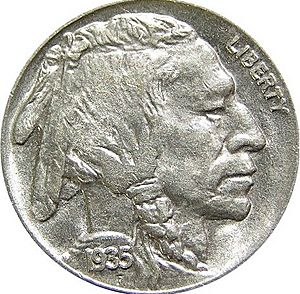Two Moons facts for kids
Quick facts for kids
Two Moon
|
|
|---|---|
| Ishaynishus, Éše'he Ôhnéšesêstse | |

Two Moon (Credit: Northwestern University Library Edward S. Curtis's The North American Indian, 2003).
|
|
| Cheyenne leader | |
| Personal details | |
| Born | 1847 Montana |
| Died | 1917 |
| Resting place | Alongside U.S. Route 212, west of Busby, Montana |
| Parents | Father, Carries the Otter |
| Known for | Participation in the Battle of the Rosebud, Battle of Little Big Horn, and the Battle of Wolf Mountain; Indian Scout; Chief of the Northern Cheyenne Indian Reservation; One of several models for the Buffalo nickel. |
Two Moons (born 1847, died 1917) was a brave and important leader of the Cheyenne people. His Cheyenne name was Ishaynishus, or Éše'he Ôhnéšesêstse. He is well-known for his role in several battles against the United States Army. These included the famous Battle of the Little Bighorn.
Contents
Life of Chief Two Moons
Two Moons was the son of a man named Carries the Otter. His father was originally from the Arikara tribe but joined the Cheyenne tribe. Two Moons became a respected chief and warrior.
He took part in several important battles:
- The Battle of the Rosebud on June 17, 1876, against General George Crook.
- The Battle of the Little Bighorn on June 25, 1876. This was a major victory for the Native American tribes.
- The Battle of Wolf Mountain on January 8, 1877. This was his last battle.
After the Battle of Wolf Mountain, General Nelson A. Miles defeated Two Moons' group of Cheyenne people. Two Moons and his band surrendered to General Miles at Fort Keogh in April 1877.
Two Moons as a Scout and Chief
After surrendering, Two Moons decided to work with the U.S. Army. He became an Indian Scout under General Miles. Two Moons was known for being friendly and getting along well with people, including the military.
Because of his good nature, General Miles made him the head Chief of the Northern Cheyenne Reservation. As chief, Two Moons helped other Cheyenne groups surrender peacefully. He played a key part in Chief Little Cow's Cheyenne band surrendering at Fort Keogh.
Northern Cheyenne Reservation Efforts
Two Moons cared deeply about his people. He traveled many times to Washington, D.C., the capital of the United States. His goal was to talk about the future of the Northern Cheyenne people. He wanted to improve the living conditions on their reservation.
In 1914, Two Moons even met with President Woodrow Wilson to discuss these important matters. He worked hard to make life better for his tribe.
Two Moons also became a part of American history in another way. He was one of the Native American leaders whose face was used as a model for the famous Buffalo Nickel coin. The sculptor, James Fraser, used him as inspiration.
Death and Legacy
Two Moons passed away in 1917 at his home in Montana. He was 70 years old. His grave is located next to U.S. Route 212, west of Busby, Montana. Two Moons is remembered as a strong leader who fought for his people and later worked to help them adapt to new ways of life.
See also
 In Spanish: Dos Lunas para niños
In Spanish: Dos Lunas para niños


